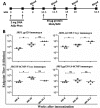Structure-based Design of Cyclically Permuted HIV-1 gp120 Trimers That Elicit Neutralizing Antibodies
- PMID: 27879316
- PMCID: PMC5217686
- DOI: 10.1074/jbc.M116.725614
Structure-based Design of Cyclically Permuted HIV-1 gp120 Trimers That Elicit Neutralizing Antibodies
Abstract
A major goal for HIV-1 vaccine development is an ability to elicit strong and durable broadly neutralizing antibody (bNAb) responses. The trimeric envelope glycoprotein (Env) spikes on HIV-1 are known to contain multiple epitopes that are susceptible to bNAbs isolated from infected individuals. Nonetheless, all trimeric and monomeric Env immunogens designed to date have failed to elicit such antibodies. We report the structure-guided design of HIV-1 cyclically permuted gp120 that forms homogeneous, stable trimers, and displays enhanced binding to multiple bNAbs, including VRC01, VRC03, VRC-PG04, PGT128, and the quaternary epitope-specific bNAbs PGT145 and PGDM1400. Constructs that were cyclically permuted in the V1 loop region and contained an N-terminal trimerization domain to stabilize V1V2-mediated quaternary interactions, showed the highest homogeneity and the best antigenic characteristics. In guinea pigs, a DNA prime-protein boost regimen with these new gp120 trimer immunogens elicited potent neutralizing antibody responses against highly sensitive Tier 1A isolates and weaker neutralizing antibody responses with an average titer of about 115 against a panel of heterologous Tier 2 isolates. A modest fraction of the Tier 2 virus neutralizing activity appeared to target the CD4 binding site on gp120. These results suggest that cyclically permuted HIV-1 gp120 trimers represent a viable platform in which further modifications may be made to eventually achieve protective bNAb responses.
Keywords: CD4 binding site; Env trimers; cyclic permutation; human immunodeficiency virus (HIV); immunogen design; immunogenicity; protein conformation; protein engineering; protein stability; protein stabilization, dynamics.
© 2017 by The American Society for Biochemistry and Molecular Biology, Inc.
Figures







References
-
- Burton D. R., Ahmed R., Barouch D. H., Butera S. T., Crotty S., Godzik A., Kaufmann D. E., McElrath M. J., Nussenzweig M. C., Pulendran B., Scanlan C. N., Schief W. R., Silvestri G., Streeck H., Walker B. D., et al. (2012) A blueprint for HIV vaccine discovery. Cell Host Microbe 12, 396–407 - PMC - PubMed
MeSH terms
Substances
Associated data
- Actions
- Actions
- Actions
Grants and funding
LinkOut - more resources
Full Text Sources
Other Literature Sources
Medical
Research Materials

